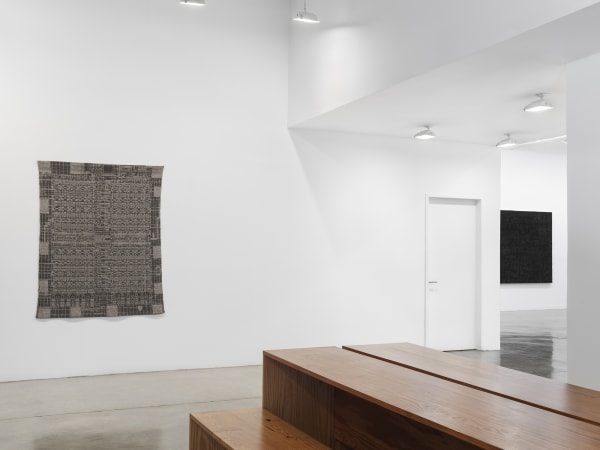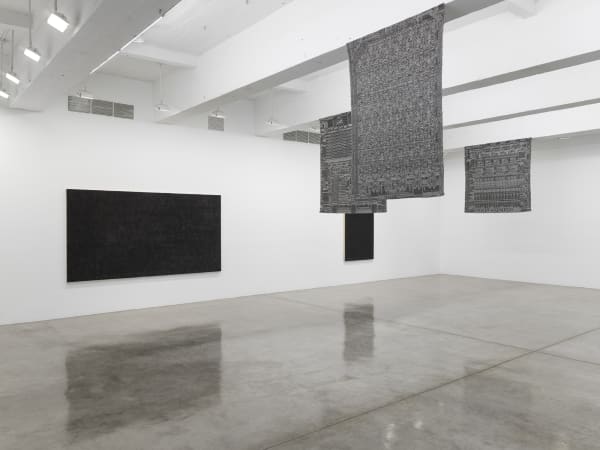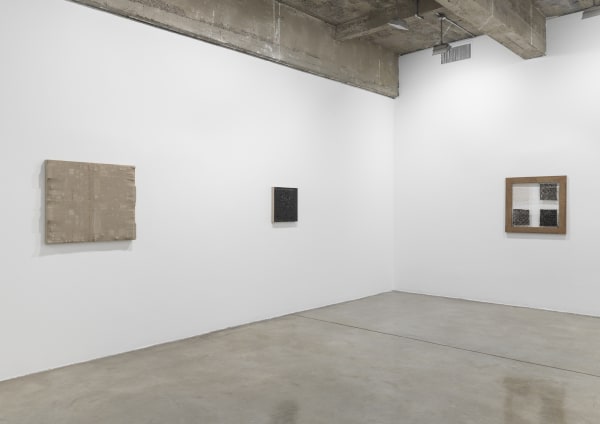Analia Saban: Punched Card: Tanya Bonakdar Gallery, New York
Tanya Bonakdar Gallery is very pleased to present its third solo exhibition with Analia Saban, Punched Card, on view from September 6 through October 18. Throughout the past decade, Saban has developed a dynamic practice that at once investigates and subverts the fundamental elements of artmaking, blurring the lines between what constitutes painting, sculpture, and everyday object. Integrating conceptual depth with a poetic formal sensibility, innovative technical processes and wry wit, Saban’s latest body of work examines the transition and contrasts between analog and digital worlds. Literally weaving together content and form, the artist continues to explore how artmaking materials have shaped the history of art, and further, the role of technology in shaping our culture. The title of the exhibition, Punched Card, refers to both analog and digital methods of information storage. Based on a binary system, punched cards were used to program the first automated looms, much like the 0s and 1s that form the digital coding language of today.
In the first floor gallery, Saban presents two related bodies of work, Pleated Ink and Tapestries, based upon the intricate geometric patterns of circuit boards. Playfully undermining the relationship between form and function, each pattern echoes a specific circuit board that has played a significant role in the history of computer technology. For instance, the microcontroller integrated circuits used by Texas Instruments—a technology that revolutionized gaming and automobile industry in the 1970s. Each work is named after the circuit that provides the basis for its respective pattern, such as Tapestry (256-Bit Static Ram, 4100, Fairchild, 1970), or Pleated Ink (Programmable Logic Chip, PAL 16L8, Monolithic Memories Inc., 1977).
Draping from the gallery’s ceiling beams as three dimensional objects, the Tapestry works deconstruct, re-appropriate, and even re-invent conventional painting elements, challenging the hierarchies of craft and fine art as well as high and low cultural production. The artist creates unusual textile pieces by interlacing linen threads as warp with long strips of dried yet pliable acrylic paint that serve as the weft. A grid of stitches emerges, giving the work its mesmerizing matrix-like structure. Each stitch can be seen as a pixel, together forming incremental pieces of data and information.
As a counterpoint to the Tapestries, Saban presents a new series of Pleated Ink paintings on the walls of the gallery. Following the same binary logic as the loom, a laser cutting machine cuts a sheet of paper in the precise pattern of a computer chip. Saban then presses the paper onto a wooden panel covered in a pool of printer ink. As a result, the ink forms lines and crevices along the exact pattern of particular computer chips, which are referenced in each title. These works are imbued with the imaginary depths of information carried on the filigree channels and wires of the microchips. Presenting the Tapestry works alongside the Pleated Ink series, Saban emphasizes the dialog between analog and digital methods of artmaking. Each of the works in both series are based on the same circuit board patterns, highlighting how these two different processes of production result in vastly disparate visual form.
The upstairs main gallery features another iconic series which uses dried acrylic paint as a weaving material to form varying compositions. In Magnetic Core Memory Structure #2, for instance, Saban employs a walnut stretcher that appears more like a loom than a framing device. Linen threads are stretched around the frame's vertical and horizontal axes, creating loose canvas through which the artist weaves strips of dried acrylic. The fibers in these works replicate the copper wire thread pattern in early Magnetic-core memory chips—a predominant form of computer memory between 1955 and 1975. The work's grid form is instantly recognizable, recurring throughout art history since Malevich and Abstract Constructivism in the early 1900s. It has been associated with minimalism, geometric abstraction, and the void of meaning and representation, especially within the museum or gallery's white cube space. Important to Saban here, however, is not the eradication of narrative from her work, but the utilitarian use of the grid in the context of a memory chip, enabling us to store and transfer information in massive quantities. In this case, the grid also functions as canvas, as carrier and support for paint.
Demonstrating yet another method by which the circuit board is employed, Circuit Board Composition (with Component Rubbings and Punctures) #1 and Distressed Canvas Circuit Board (with Component Rubbings and Punctures) #1 are created by the artist physically attaching and pressing circuit boards to and through the back of stretched canvas. Whereas in the Pleated Ink works the relationship to circuit boards is more allusive and impressionistic, in these “rubbing” pieces the circuit board physically forms the lines and shapes that appear on the surface of the canvas, and at times even puncture through the canvas to reveal its metal components. We see direct traces and actual parts of objects which carried myriad lines of coding—data banks that in many ways contain much of our lives. One work, for example, incorporates a motherboard recycled from a well-known online dating platform. One might envision the hopes, dreams, passions and emotional complexities translated into bits and bytes that once flowed through the veins of the circuit board—now returned to the formal limitations of a discreet object, partially obscured, and wrapped in canvas: a ghost.
Born in 1980 in Buenos Aires, Argentina, Saban currently lives and works in Los Angeles, California. She received a BFA in Visual Arts from Loyola University in New Orleans in 2001, followed by an MFA in New Genres at the University of California in Los Angeles in 2005. Saban’s works are represented in the collections of the Hammer Museum at UCLA, Museum of Contemporary Art, and Los Angeles County Museum of Art in Los Angeles; Hessel Museum of Art at Bard College in New York; Norton Museum of Art in Florida; Centre Pompidou in Paris, Fundación Proa in Buenos Aires, and The Israel Museum in Jerusalem, among others.
All installation images above: Photo by Maris Hutchinson









